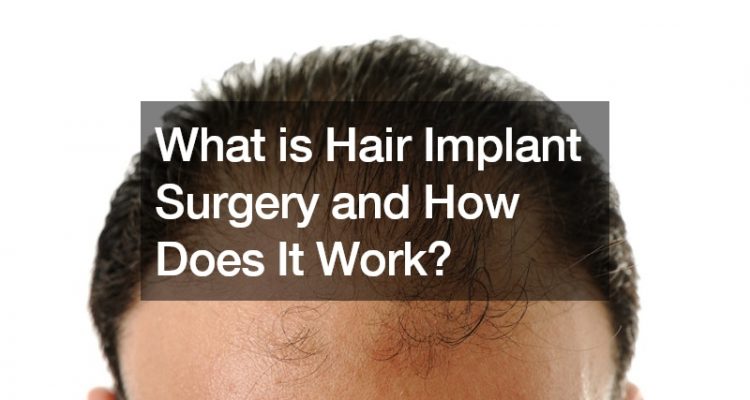
Hair loss is a common concern affecting millions of individuals worldwide. While some embrace their baldness, others seek solutions to restore their hair and confidence. Among the various options available, hair implant surgery stands out as a popular and effective choice. This article delves into what hair implant surgery is, how it works, and what one can expect from the procedure.
Understanding Hair Implant Surgery
Definition and Purpose
Hair implant surgery, also known as hair transplantation, is a medical procedure that involves implanting hair follicles to the affected areas. The primary purpose of this surgery is to restore a natural-looking hairline, enhance hair density, and boost the patient’s self-esteem.
Types of Hair Implant Surgery
There are two main techniques used in hair implant surgery:
Follicular Unit Transplantation (FUT):
In this method, a strip of scalp containing hair follicles is removed from the donor area, usually at the back of the head.
The strip is then divided into individual follicular units under a microscope.
These units are implanted into the balding areas of the scalp.
Follicular Unit Extraction (FUE):
This technique involves extracting individual hair follicles directly from the donor area.
The follicles are then implanted into the thinning or bald areas.
FUE is less invasive than FUT and does not leave a linear scar, making it a preferred choice for many patients.
The Procedure: Step-by-Step
Pre-Surgery Consultation
Before undergoing hair implant surgery, a thorough consultation with a qualified surgeon is essential. During this consultation:
Medical History: The surgeon will review the patient’s medical history to identify any potential risks or contraindications.
Scalp Examination: A detailed examination of the scalp helps determine the extent of hair loss and the suitability of the donor area.
Discussion of Goals: The patient and surgeon will discuss the desired outcome, setting realistic expectations for the surgery.
Preparation
On the day of the surgery, the patient should follow the preoperative instructions provided by the surgeon, which may include:
Avoiding certain medications or supplements that could increase bleeding.
Washing the hair thoroughly to ensure a clean surgical area.
Wearing comfortable clothing, as the procedure can take several hours.
The Surgery
Anesthesia:
Local anesthesia is administered to numb the donor and recipient areas, ensuring the patient remains comfortable throughout the procedure.
Extraction:
For FUT, a strip of scalp is removed, and the area is sutured.
For FUE, individual follicles are extracted using a specialized tool.
Preparation of Follicles:
The harvested follicles are carefully prepared for implantation. In FUT, the strip is dissected into individual units, while in FUE, the extracted follicles are cleaned and sorted.
Creating Recipient Sites:
The surgeon creates tiny incisions in the recipient area where the follicles will be implanted. The placement and angle of these incisions are crucial for achieving a natural-looking result.
Implantation:
The prepared follicles are meticulously implanted into the recipient sites. This process requires precision and skill to ensure proper alignment and density.
Post-Surgery Care
After the surgery, the patient will receive specific instructions for post-operative care, which may include:
Medications: Prescribed medications to manage pain, prevent infection, and reduce swelling.
Hair Care: Guidelines on how to wash and care for the newly implanted hair.
Activity Restrictions: Advising on avoiding strenuous activities and protecting the scalp from direct sunlight.
Recovery and Results
Immediate Aftermath
Swelling and Discomfort: Some swelling and discomfort in the donor and recipient areas are normal and typically subside within a few days.
Scabbing: Tiny scabs may form around the implanted follicles, which usually fall off within a week or two.
Hair Growth Timeline
Initial Shedding: The implanted hair follicles may shed within the first few weeks, a natural part of the hair growth cycle.
New Growth: New hair growth typically starts three to four months after the surgery.
Full Results: It can take 9-12 months to see the full results, as the hair continues to grow and thicken.
Benefits of Hair Implant Surgery
Natural-Looking Results
Hair implant surgery offers natural-looking results, as the patient’s own hair is used for the transplant. This ensures that the texture and color match seamlessly with the existing hair.
Permanent Solution
Unlike temporary solutions such as wigs or hairpieces, hair implant surgery provides a permanent solution to hair loss. The implanted hair follicles continue to grow naturally, requiring no special maintenance.
Improved Self-Esteem
For many individuals, restoring a full head of hair significantly boosts confidence and self-esteem, improving their overall quality of life.
Conclusion
Hair implant surgery is a highly effective and popular method for addressing hair loss and restoring confidence. By understanding the procedure, preparation, and recovery involved, individuals can make informed decisions about whether this treatment is right for them. With advances in medical technology and techniques, hair implant surgery continues to offer natural, lasting results for those seeking to regain their hair and self-assurance.
.

